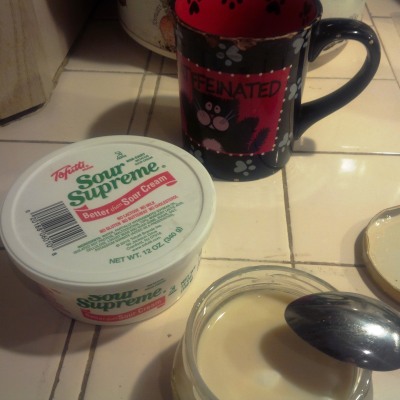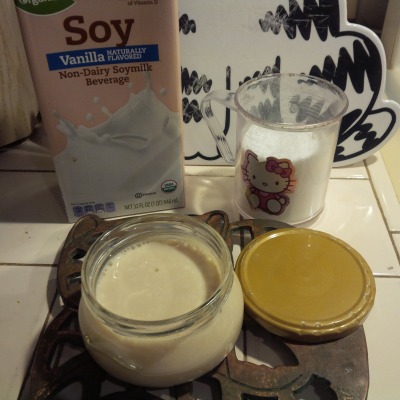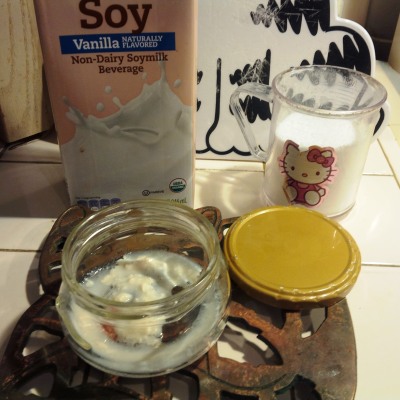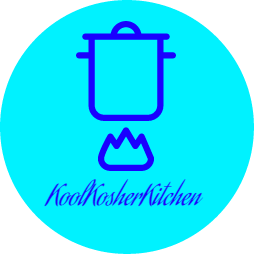I have promised to share a method of making prostokvasha, or clabbered milk. Prostokvasha in Russian means “fermented simply,” which is exactly what clabbered milk is; it’s simply raw, or non-pasteurized milk left in specific temperature and humidity to ferment on its own, naturally, until it turns into a thick yogurt-like substance. In Russia, it was eaten on its own, as a snack, and considered one of the best hangover remedies. We used it also to make farmer cheese and as a base for all kinds of pancakes which is what prompted this post to begin with. It looks like you, beautiful people out there, love pancakes!
A while ago, one of the bloggers I follow, Rach of the life of a onesie wearer, asked her readers if – and how – they made pancakes from scratch. In my comment, I promised to show how to make the base before I posted any actual pancake recipes. So here it is, Rach and everyone else, nice, simple, non-dairy and gluten free.
There is plenty of research indicating that fermented foods, full of probiotics, promote digestive health. Fermented foods include such staples as pickles or sauerkraut, easy to make at home, or kombucha that costs a fortune at your local health food store. Clabber is one of the most effective fermented foods because, in contrast to fermented veggies or drinks, it has protein, as well as some vital minerals. But, as I have discovered when I came to the U.S., there is a problem, as all milk sold here is pasteurized.
Not aware of the difference, I went through the same tried and true procedure that worked in my grandmother’s kitchen in Odessa: I put a tablespoon of sour cream into a glass, filled the glass with milk, covered it, and left it on the counter overnight. I opened it in the morning, shook it up a little to see if it solidified, and – nothing! Still the same milk. I left it there for the entire day and checked again in the evening, then again the next morning – zilch! Maybe, I thought, American store-bought sour cream that is much lower in fat than what we had bought from a farmer, is not doing the job, so let’s add some more of it, and so I did, another tablespoon. A day later, when it showed some signs of curdling, but not solidifying, as it should have, I chanced to taste it – yech! Spoiled, rotten, and bitter.
It was not many years later, as I was told that I should avoid dairy products and had to switch to soy milk, that I discovered Tofutti – my best friend! – and decided to experiment.

I followed the same exact method: put a tablespoon of Tofutti Sour Supreme into a glass jar and filled the jar with soy milk. Holding my breath, I covered it and left it on the counter overnight.

Miracle of miracles! By morning, it has solidified. I now had my prostokvasha to enjoy as breakfast or a late night snack, to make non-dairy pancakes, and to add to cakes and muffins for extra fluffiness.

It can stay in your refrigerator next to forever, and just in case you run out of Sour Supreme, leave about a teaspoon of it for a starter and just fill the jar with soy milk. And if you also run out of soy milk, coconut milk will work, but not rice or almond milk. And if you don’t have either soy or coconut milk, simply refrigerate your starter until such time as you get it, and repeat the procedure.
Oh, and by the way, if you want it dairy, you can still do it the old-fashioned way, as long as you can get non-pasteurized milk and sour cream with no chemical additives, the fatter, the better.
INGREDIENTS
- 1 cup / 8 oz soy or coconut milk
- 1 tablespoon Tofutti Sour Supreme (alternatively, coconut kefir will create a starter)
PROCEDURE
- Put a tablespoon of Sour Supreme into a glass, ceramic, or enameled container. Fermented foods cannot be made or kept in metal, wood, or plastic because of the active bacteria generated by the fermentation process.
- Add a cup of soy or coconut milk. Soy milk will solidify faster, but ultimately it depends on temperature and humidity in your kitchen.
- Cover tightly and leave for at least 10 hours in a warm place.
- To check for doneness, remove cover and shake gently. It is done when it looks like a solid mass, resembling Greek yogurt.
- Refrigerate immediately to avoid over-fermenting. If it over-ferments and starts curdling, it is still excellent for cooking and baking, but not really edible on its own.
- When using prostokvasha, don’t forget to leave a starter for next time.
Enjoy!

that’s really interesting! I used to love kind of buttermilk but have never seen or tasted anything similar here, in the UK (the simple, fresh buttermilk I had was easily available in Iceland)- I might try this, thank you!
LikeLiked by 1 person
My pleasure – enjoy!
LikeLike
Maybe you were using ultra-pasteurized milk?
By now there are very good Greek yogurts and I can get Israeli labane and other cheeses, and Russian Kefir, so it’s been a while since I tried, but I used to make yogurt/labane with regular fresh pasteurized milk and it worked.
But it’s great to know that it works with non-dairy items.
LikeLiked by 1 person
I love Israeli labane, but unfortunately, have to avoid dairy products. I have no idea what I used when I first came to this country – everything was new and different!
LikeLiked by 1 person
Yes, I know how it feels… 🙂
LikeLike
Now, I really have to try this. My mother used to love this, but I don’t think we ever ate it. Now, I am curious!
LikeLiked by 1 person
You have, if you ever tasted buttermilk. It is practically the same, but if you make it at home, you regulate the thickness. You want it to be as thick as sour cream, to make your latkes, pies, and cakes fluff up.
LikeLiked by 1 person
I never knew that! I always wondered why so many cakes recipes suggested buttermilk or yogurt. Now I know.😊
LikeLiked by 1 person
The advantage of mine is that it is non-dairy, so you can make all kinds of pareve things.
LikeLiked by 1 person
It’s a great idea. I am going to try it.
LikeLiked by 1 person
Good luck, and if it smells sour, don’t worry – it is supposed to!
LikeLiked by 1 person
Thanks. It will be a culinary adventure.
LikeLiked by 1 person
Adventures make life interesting!
LikeLiked by 1 person
What a creative prostokvasha recipe! Thank you for sharing!
LikeLiked by 1 person
Thank you! Didn’t you make it this way in Moscow? We did, in Odessa, and then we used it to make tvorog, and we used tvorog to make syrniki, which reminds me to make and post them…
LikeLiked by 1 person
I never made it, just bought it. And bought tvorog. But definitely made syrniki — one of my all-time favorite foods :).
LikeLiked by 1 person
My grandmother held that homemade prostokvasha and tvorog were better, and anyway everything homemade was better, in her opinion. It really helped me when I had to give up dairy products; I started making everything “homemade non-dairy.”
LikeLiked by 1 person
Dolly that is really amazing and I thank you profusely. I love Tzotzil I but always a problem when having my shawarma and I am not a lover of humus. I am most definitely going to try this and keep it. Thanks once again and Shabbat Shalom for the weekend. Kind regards Hannah❤
LikeLiked by 1 person
I am so glad you find it helpful! Shabbat Shalom! All the best,
Dolly
LikeLike
You can’t buy legal fresh milk any places in EU either, all need to be pasteurized to avoid bad bacteria. I will try this out with coconut milk, because I have allergy to soy of any kind.
LikeLiked by 1 person
I’ve made it with coconut milk, and it works fine, but what will you use for a starter? You’ll need a coconut yogurt or kefir.
LikeLiked by 1 person
I don’t have allergy to cow milk products, if I don’t abuse them, so I think, that I will use 1-2 spoons of Greek Yoghurt as a starter.
LikeLiked by 1 person
In that case, I suggest you make a fully dairy prostokvasha first, and then use it as a starter with coconut milk. Also, using sour cream for the dairy prostokvasha will work better than Greek yogurt.
LikeLiked by 1 person
Okay, I will try that, thank you Dolly 🙂
LikeLiked by 1 person
My pleasure, dear Irene – enjoy!
LikeLiked by 1 person
Yummy! Шабат шалом ❤
LikeLiked by 1 person
Wow – writing in Russian!
Shabbat Shalom and Hag Sameach, David!
LikeLike